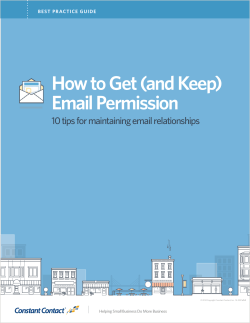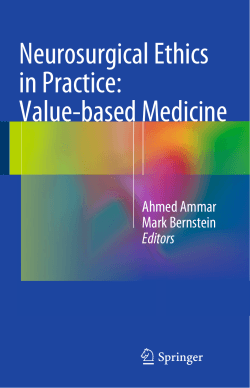
How to Apply for Ethics Approval from the Sociology Department
Sociology Ethics Review How to Apply for Ethics Approval from the Sociology Department (adapted from Acadia University REB)1 ETHICS GUIDELINES FOR STUDENT RESEARCH USING QUALITATIVE RESEARCH ............... 2 Preparing your application ................................................................................................................. 2 Application for Ethical Review of Research Involving Humans ............................................. 3 Research Consent Form ....................................................................................................................... 4 Consent Form Checklist ........................................................................................................................ 6 ETHICS GUIDELINES FOR STUDENT RESEARCH USING ANONYMOUS SURVEYS ................... 7 GUIDELINES .............................................................................................................................................. 7 1 Revised September 2011 1 Sociology Ethics Review ETHICS GUIDELINES FOR STUDENT RESEARCH USING QUALITATIVE RESEARCH Preparing your application All applications must be prepared electronically. The application form is a downloadable Microsoft Word document containing cells into which you can easily enter the required information. For each project, the researcher must prepare an application containing the following: a. The application form (page 3) b. The research summary (see below) c. The consent forms that will be used (pages 4-5) d. Any surveys, questionnaires, or interview questions (or guides) that will be used e. Any advertisements that will be used to alert or attract research subjects f. Consent form check list (page 6) The research summary should contain the following information (use the headings provided): 1. Purpose: the objectives of the study; its hypotheses (if any); why the study is needed 2. Methodology: how the subjects will be chosen, how they will be contacted, and by whom; who will conduct the research and where; what the subjects will be asked to do; what data will be taken 3. Consent: how informed consent will be obtained (Note: The REB requires parent/guardian consent for research subjects under 18 years of age.) 4. Debriefing: how the subjects will be debriefed following their participation 5. Risks: any expected risks to the subjects and how such risks will be minimized 6. Safety: if applicable, how the safety of subjects will be monitored 7. Confidentiality: how the confidentiality of the subjects and data will be assured 8. Deception: if deception will be used, you need to apply to Acadia’s REB 2 Sociology Ethics Review Application for Ethical Review of Research Involving Humans Sociology Ethics Review Research Consent Form Date The form should be dated at the top of each page. This should be the date of department ethics committee approval of the project. The objective is to ensure that any subsequent amended version of the Research Consent Form can be easily identified. Title and Indication that this is a Research Project An appropriate title can help to convey that the proposed project is for research rather than for educational, treatment, or other purposes. In addition, the beginning of the text must indicate that the individual is being invited to participate in a research project. Researchers The identity of the researchers should appear immediately below the title of the research project. You need to explicitly state that you are a student and the consent form should include the name and telephone number of the student’s supervisor. Purpose of the Research A brief description of the purpose of the research should explain the topic that is being explored or the hypothesis that is being tested and what the research is supposed to find out. The description should be in language that is comprehensible to individuals in the population from which the participants are being drawn. If there are specific inclusion and exclusion criteria for research participation, these can be noted here. Description of the Research A step-by-step description of the research as it will be experienced by the research participant must be provided (e.g., completion of a questionnaire, answering questions of a personal nature in a private interview, testing of a new drug, surgical intervention, or being asked to solve problems), and it must clearly explain the expected length of her of his participation in the research. Potential Harms To further the goal of voluntariness, potential harms should be listed prior to potential benefits. To get departmental ethics approval the research you are doing must be minimal harm. Any research that may have foreseeable harms, including physical, emotional, and psychological harms and inconveniences (e.g., regret over the revelation of personal information to an interviewer, disruption of family routine, long waits, revelation of personal information never shared before) will need approval from the University Research Ethics Board. Suggested Wording: “There are no known harms associated with your participation in this research. However, there may be harms that we don’t yet know about.” Potential Benefits If there are no potential benefits to the prospective research participant, this must be stated explicitly. If there are potential benefits to the participant, these should be described as accurately as possible. This 4 Sociology Ethics Review description should include relevant information about the nature of the potential benefits and the probability of occurrence. Suggested wording: “There are no known benefits to you associated with your participation in this research” “You will not benefit directly from participation in this research.” Confidentiality Under Section 3 of the Tri-Council Policy, researchers are expected to indicate to research subjects the extent of the confidentiality that can be promised. It is not always possible to keep confidentiality and this must be stated clearly. Participants also have the right to waive confidentiality. It is important for the prospective research participant to know who will have access to the research data/samples, and how such data/samples will be stored. Suggested wording: “Confidentiality will be respected. No information that discloses your identity will be released or published without your specific consent to the disclosure.” “If we find information we are required by law to disclose (e.g., child or elder abuse, inability to hold a valid driver’s license, etc.), we cannot guarantee confidentiality.” Publication The Research Consent Form should include a description of the ways in which the research results will be published, and how the participants will be informed of the results of the research and of their publication. It should also state whether the participant’s identity will be revealed in any such publication. In every case, participants must at least be told whether or not their identity will be protected in reporting the results Participation The prospective research participant must be told very explicitly that she or he has the right to refuse to participate in the proposed research and, moreover, that a decision to participate in the research is not binding. It is important to make it clear that participant withdrawal may be made at any time without negative consequences. It is equally important to advise participants that withdrawal of their participation does not necessarily include withdrawal of any data compiled up to that point. Suggested wording: “Participation in research must be voluntary. If you choose to participate and later decide to change your mind, you can say no and stop the research at any time. However, withdrawal of your participation does not necessarily include withdrawal of any data compiled up to that point”. Consent This section may provide a brief (one paragraph) summary of the research stating that the potential harms, benefits, and alternatives have been explained. There should be a statement to the effect that the prospective research participant: (1) has read and understood the relevant information; (2) understands that she or he may ask questions in the future; and (3) indicates free consent to research participation by 5 Sociology Ethics Review Consent Form Checklist This checklist is designed to assist researchers in drafting, and faculty in reviewing, Research Consent Forms. The checklist enumerates elements that should be included in the Research Consent Form. Carefully review the draft consent form and check each element that is present. The form clearly identifies: ____ the researchers, and if any researcher is a student, the student’s supervisors (the person who is available to answer pertinent questions should be clearly identified); The consent form clearly explains: ____ that the proposed intervention is for research ____ the purpose of the proposed research ____ the nature of the proposed research ____ the likely duration of participation ____ the potential harms and inconveniences associated with the research ____ the potential benefits associated with the research ____ whether confidentiality will be protected and the measures taken to ensure it ____ that participation in research is voluntary (the right to refuse and the right to withdraw without prejudice) The consent form is written: ____ in the prospective participant’s (or her or his substitute decision-maker’s) preferred language; ____ in lay terms (ordinary language); ____ at an appropriate level, taking into consideration the nature of the participant (e.g., child or adult). 6 Sociology Ethics Review ETHICS GUIDELINES FOR STUDENT RESEARCH USING ANONYMOUS SURVEYS ACADIA UNIVERSITY Department Of Sociology GUIDELINES Anonymous surveys require ethics approval but do not require a SIGNED informed consent document. In order to ensure anonymity: 1. Subjects cannot have their names on their surveys or on informed consent documents. 2. No open-ended questions can be included that would provide the ability of the researcher to trace the handwriting of a subject. 3. Researchers should take care in the collection of surveys so as not to see subjects’ responses to items that would allow the researcher to know of the subjects’ answers (e.g. place all surveys in an envelope and enter data after collecting all the surveys). 4. Care should be taken in asking questions in a survey that could possibly lead to the matching of survey answers to subjects (e.g. If you are surveying all international students and know that there is one who is 84 years old and age is not a relevant variable in your study, you may elect not to include age as a variable in order to protect the 84 year old subject’s anonymity). For student researchers carrying out anonymous surveys ethics approval requires the following: 1. The application form 2. Research summary 3. For Anonymous Surveys related to Honour’s Student Theses: A copy of the survey with informed consent statement Other Information Regarding Informed Consent Documents 1. The Informed Consent Statement must include a phrase to the effect of “Once a survey is handed in, data cannot be traced back to individual respondents. By completing this survey, you are consenting to have your survey responses included in this research.” 2. The informed consent statement can be a paragraph at the top of the survey or it can be a longer document following the guidelines of a more traditional informed consent document which would be handed to the subject. 3. It is recommended that the subject be given contact information of the researcher or their supervising professor, should the subject later have questions regarding the study. 7
© Copyright 2025

















